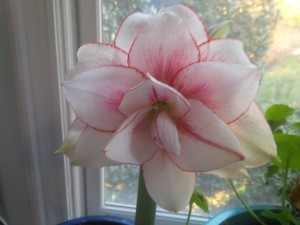 When I was growing up, poinsettias, especially red ones, reigned supreme in the holiday decorating sweepstakes. Big stores arranged hundreds of them in tiers to look like giant red Christmas trees. The crimson blooms adorned church altars and ornamented multiple rooms in large houses. People with a more modern aesthetic sometimes turned to white poinsettias instead of red ones, the better to complement minimalist décor, but the end result was the same—a plethora of poinsettias.
When I was growing up, poinsettias, especially red ones, reigned supreme in the holiday decorating sweepstakes. Big stores arranged hundreds of them in tiers to look like giant red Christmas trees. The crimson blooms adorned church altars and ornamented multiple rooms in large houses. People with a more modern aesthetic sometimes turned to white poinsettias instead of red ones, the better to complement minimalist décor, but the end result was the same—a plethora of poinsettias.
Poinsettias are still with us, of course, available now in a wider range of colors and forms, including fluffy doubles, pink-flowered varieties and bi-colored specimens that look like splatter art targets. They are still everywhere, but in this season’s holiday decorations, I have noticed that poinsettias’ long pre-eminent position has been supplanted by amaryllis, used as cut flower as well as specimen plant form.
The cut flower use is the biggest departure from past practice, and indicates that commercial growers have been busily cultivating hundreds of large amaryllis bulbs to meet the rising demand.
Those of us who grow amaryllis, known botanically as Hippeastrum hybrids, know that one giant bulb will yield two, or sometimes three, thick flower stalks, each bearing four outward-facing trumpets in shades of white, cream, pink, red, yellow or pale green. The flowers can be single or double, and last up to five days on the stalk. If you cut the stalks to use the blooms as cut flowers, you will have only two or three stems per bulb. Because the flowers are very large, even that small number of stems can yield a flashy result. However, if you are decorating a large space, you are going to need a lot of amaryllis bulbs to produce the number of flowers needed to create a significant holiday splash.
A few days ago, I went to an open-house in a large, historic dwelling that boasted opulent holiday decorations. One room featured a row of eight or ten double white amaryllis, their pots artfully concealed with evergreen boughs. Another room was adorned with sumptuous cut flower arrangements highlighted by even more of those white amaryllis. Strolling through the many large rooms, I noticed amaryllis on mantelpieces, springing forth from urns, and even affixed to Christmas trees. The sense of drama and abundance was palpable.
Being extremely impressionable, especially where flowers are concerned, I found myself coveting amaryllis. At the same time, I knew that given the state of my pocketbook, I probably couldn’t afford to buy large numbers of cut stems from a florist.
This latest manifestation of the amaryllis vogue has long roots. The ancestor of the modern amaryllis or Hippeastrum hybrids, the red-flowered Hippeastrum reginae, first arrived in Europe in the early eighteenth century. Hybridizing efforts began, and in 1799, Hippeastrum x johnsonii, a reginae offspring, was born. That development energized breeding enthusiasts and by 1830, at least 100 named hippeastrum hybrids had been created.
Amaryllis has ridden repeated waves of popularity throughout the nineteenth, twentieth, and now, twenty-first centuries. Right now, catalogs, garden centers, mass merchandisers and even supermarkets are full of the giant bulbs, either unadorned in bins or packaged in planting kits along with plastic pots and bags of planting medium. However, if you want to grow the stems for holiday cutting purposes, it is too late to start this year. Planting bulbs now will yield flowers in about four weeks—time enough to brighten winter arrangements after the holidays, but not in enough time for the celebrations that are upon us in the next few weeks.
If you are already thinking of next year, make a note to yourself to order a number of amaryllis bulbs in August or September, when catalog merchandisers offer the largest number of bulbs. Sometimes you can get deals if you buy multiples, which is perfect for cut flower applications. When your bulbs arrive, they will be flush with the stored energy needed to produce flowers. Plant them in potting medium, covering only about the bottom third of the bulb with soil, and water sparingly. You can also force the bulbs by positioning them atop water-filled glass jars or forcing containers, with the bulbs’ bottoms just above the water line. This technique allows you to have the fun of watching the roots develop as the flower stalks emerge. The stalks grow tall, and you may have to stake them as the flowerheads mature. For optimum vase life, it is best to cut the stalks just as the large buds start to open. Plunge the stalks and any other design elements into water right away, and change the water every couple of days to keep the arrangement fresh.
Amaryllis bulbs can and will produce flowers in subsequent years. You can force them to bloom at specific times, by following a regimen of regular care followed by a defined period of light and water deprivation. I treat mine as regular houseplants. After flowering, I allow the long, strappy leaves to grow out, while I continue watering and feeding the plants. They go outside in the summer and come back inside in the fall. Eventually they rebloom on their own schedule. Next year I hope to use some of those flowers in cut flower arrangements.
Purchase amaryllis bulbs—for now and later–at your local garden center or mass merchandiser. You can also order from John Scheepers, 23 Tulip Drive, P.O. Box 638, Bantam, CT 06750 ; (860)-567-0838; www.johnscheepers.com . Print catalog available.
